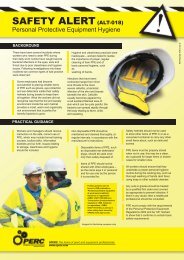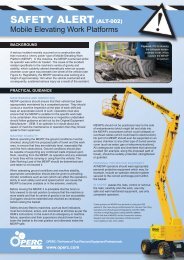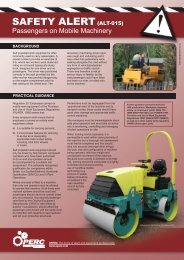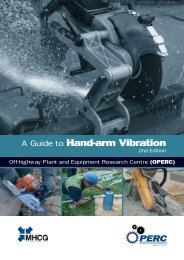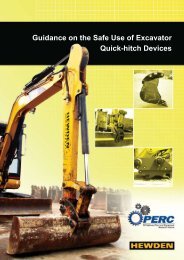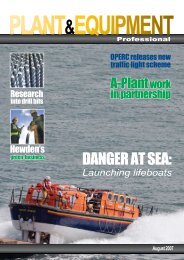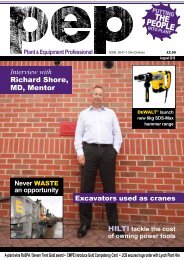Plant&Equipment
Download pdf - OPERC
Download pdf - OPERC
- No tags were found...
Create successful ePaper yourself
Turn your PDF publications into a flip-book with our unique Google optimized e-Paper software.
Special report<br />
vividly shows what can happen to an operator if he<br />
or she is untrained or the machine is not properly<br />
maintained. This video would certainly hit home and<br />
you could see the trainees’ faces grimace at the<br />
staged accidents. (The HSE also has some<br />
excellent free training information PDF downloads<br />
on their website.)<br />
So just what makes All Terrain Vehicles dangerous to<br />
operate? The RNLI used Honda TRX 450S Fourtrax<br />
Foreman quads; these bikes weigh 274kg and their<br />
432.6cc engines make them capable of speeds over<br />
60mph. They have a five speed auto transmission<br />
and two or four wheel drive - all in all they are a<br />
powerful heavy machine.<br />
To operate these bikes safely you need to be able to<br />
move your body weight backwards, forwards and side<br />
to side - hence the big saddle. There is no differential<br />
unit in the rear axle; it is just a crown wheel and<br />
pinion, with the crown wheel being fixed directly onto<br />
a solid bar axle. There is a differential unit in the front<br />
drive unit with half shaft and constant velocity joints<br />
at the wheels and gearbox end, which enables you<br />
to steer. As a consequence of the set up with the<br />
rear axle (both wheels turning at the same speed,<br />
fixed) when you come to corner with the bike the rear<br />
wheels are trying to push you straight ahead, which<br />
can cause the bike to roll over. To counteract this<br />
effect you need to move your body weight out to one<br />
side, the opposite side to the corner you are turning.<br />
This allows the nearside wheel to lift slightly and skit<br />
the surface with the offside wheel pushing you round<br />
the radius of the corner; in effect the opposite to a<br />
motor cycle. If you have ever ridden an ATV on hard<br />
surfaces you will know just how hard they are to steer<br />
even when shifting body weight.<br />
Ascending, descending or transversing gradients is<br />
especially dangerous and again the big seat comes<br />
into effect. One of the biggest causes of injury or death<br />
is front or rear wheel overturns. So when ascending a<br />
gradient you need to move your body weight forward<br />
almost at an angle to the gradient. When descending<br />
you need to move your weight back<br />
towards the rear of the bike, again<br />
at an angle relative to the slope.<br />
When transversing a gradient<br />
(which should be avoided if<br />
possible) you must move your body<br />
weight into the hillside, again at an<br />
angle relevant to the slope.<br />
distributed evenly between front and rear carriers.<br />
Certainly – no passengers allowed.<br />
With regards to trailers, the maximum tow hitch tongue<br />
weight (downward load) is just 14kg. The tow hitch ball<br />
is attached directly to the rear axle so if this weight is<br />
exceeded the effect is to lift the front end of the bike;<br />
the rear axle becomes the fulcrum point, which in turn<br />
lifts the front wheels seriously affecting the steering.<br />
If the load on the trailer is too far back then the tail<br />
weight comes into play, with a lifting effect on the rear<br />
wheels causing loss of traction. Most ATV’s can tow<br />
about double their kerb weight but the trailer must<br />
be loaded evenly allowing the axle of the trailer to<br />
become the fulcrum; too much load and the tail begins<br />
to wag the dog<br />
Finally let us consider PPE. First and foremost a<br />
helmet must be worn; they are a lot harder than your<br />
skull! Snag proof clothing and safety boots are also<br />
essential. Having said that I will leave you with one<br />
last thought - can you imagine the training nightmare I<br />
had with beach lifeguards? These girls and boys do a<br />
fantastic job and are the unsung heroes of the RNLI.<br />
They save many lives each year but with bleached<br />
blond long hair and sunglasses there can be a<br />
certain Bay Watch image to keep up! I had the task of<br />
reaching a compromise with lifeguards, managers and<br />
the HSE as to what they would and should wear. Steel<br />
toecap boots were out of the question, as was snag<br />
proof clothing, but I did win the helmet argument - all<br />
our lifeguards wear a specially designed water craft<br />
Gecko Helmet.<br />
If you are going to ride an All Terrain Vehicle get<br />
trained and you have a real work friend. Ignore<br />
training and your ATV could become your worst foe!<br />
Remember this: if you think the cost of training is high,<br />
think just how much the cost of ignorance is!<br />
Pictures kindly donated courtesy of the RNLI.<br />
Technical data by: Graham Eaves,<br />
Machinery Training Instructor RNLI, retired.<br />
The bikes can carry loads and<br />
are fitted with carriers front and<br />
rear. There are warning notices<br />
instructing the operator of the<br />
maximum load to be carried<br />
and ideally the weight should be<br />
February 2008<br />
39



